|
Our
film opens with a slow, cosmic pan of our
solar system. But things soon speed up as
we accelerate toward the third planet from
the sun, through the atmosphere, and zero
in on a city. (I think it's
Chicago, but it's never verified by the
film.) We continue to zoom in
closer ... to a street, to a building ... and
finally stop at a window, revealing a small
apartment behind the glass. Once
inside, the pan continues, revealing a
woman sprawled out on the bed, and finally
settle on an alarm clock -- that reads 1:30
pm. And
while pondering if this woman is a lazy
late sleeper, we then slide down a little
more to find an empty bottle of sleeping
pills, right by her prone hand. The
tragic signs are clear, but the woman,
Nora King (Kathleen
Crowley), stirs, and then wakes up,
groggy and disoriented, with an enormous
headache. (Yes ... it was an attempted
suicide, but there weren't enough pills.)
Trying to pull herself together, she
attempts to wash her face but no water
comes out of the spigot. Turns out the
lights don't work either -- there's no
electricity. Looking out the window, the
city streets appear deserted and
abnormally quiet for that time of day. Checking
on her neighbors, Nora finds no one home
-- but with the door unlocked and uneaten
food on the table, these are just a few of
the signs and evidence that they all must have
left in one helluva hurry.
Heading
outside, there is still no traffic, no
movement, and no signs of life to greet
our protagonist; it's also
very quiet, too quiet (--
he typed ominously),
and thinking maybe she did die
after all and this is her own version of
hell, sheer panic starts to overwhelm poor
Nora. And as her frantic search for some
sign of life intensifies, she rounds a
corner and trips over something. Then,
once she
recovers her footing, the girl soon
realizes that what she tripped over was
the dead body of a woman! Slowly,
a shocked Nora backs away from the corpse
-- right into another man. Thinking he
must be the killer,
Nora screams and runs away for him. But
the mysterious
man quickly gives chase, determined to
catch her before she gets away...

First
bitten by the showbiz bug while rapidly
working his way from janitor, to
projectionist's assistant, to usher, to
head manager at a local theater in his
native Detroit, Herman Cohen, after a brief stint in the
Marines, and barely in his twenties,
then took a job as sales manager for
Colombia Pictures' Detroit branch, and
later made the move to Hollywood to work
in the same studio's publicity department.
This was about the same time that fellow Detroiter
Jack Broder began re-releasing Universal's
old monster movie catalogue through his
Realart Pictures. And wanting to produce his
own films, Broder hired Cohen on as his
production assistant, allowing his new hire to
learn the nuts and bolts of the trade as Realart
quickly and cheaply churned out
two films: Bride
of the Gorilla,
whose production, including the tragic
tale of lead actress Barbara Payton and
her illicit ménage à trois with actors
Tom Neal and Franchot Tone (-- that ended
violently shortly after the film was in
the can), is a lot more interesting than
the finished product, and Bela
Lugosi Meets the Brooklyn Gorilla, featuring
the horribly --
make that painfully, unfunny antics of the
Dean Martin & Jerry Lewis knock-offs,
Duke Mitchell & Sammy Petrillo,
which
seemed to ignite the fledgling producer's
life-long obsession with men in monkey-suits.
And after a few more co-productions over
in England with Nat [no relation] Cohen's
Anglo-Amalgamated, Herman
Cohen was finally ready to fly solo and
make his own movie.
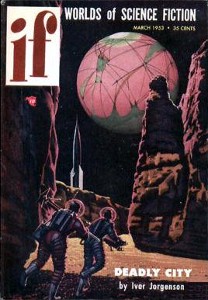 Now,
the origin of this inaugural effort began
while he and
Jim
Nicholson -- yes that Jim Nicholson, who
was Cohen's assistant at Realart at that
time in 1953 -- walked past a newsstand
where a certain pulp-magazine cover caught
Nicholson's eye (-- or
Cohen's eye, depending on which version
you believe). In this particular
issue of If
... Worlds of Science Fiction
was a short story by author Paul W.
Fairman entitled The Deadly City.
Written under the pen name of Ivar Jorgenson,
Fairman's
tale of an apocalyptic extraterrestrial
invasion picks up sometime after the
belligerent
aliens landed and leveled Michigan, and
then picks up as they lay siege on Chicago.
Focusing on the tribulations of four
characters left behind after a mass evacuation
(-- a suicidal prostitute, a
salesman, a charming gangster and his
submissive girlfriend), who are
caught in the crossfire between the
unstoppable invaders, the military,
and an escaped psychopath, the gist of the
story is more concerned with the crisis within than a
tempest without, and like H.G.
Wells' Martians, when all seems hopelessly
lost, Fairman's aliens mysteriously drop
dead. Now,
the origin of this inaugural effort began
while he and
Jim
Nicholson -- yes that Jim Nicholson, who
was Cohen's assistant at Realart at that
time in 1953 -- walked past a newsstand
where a certain pulp-magazine cover caught
Nicholson's eye (-- or
Cohen's eye, depending on which version
you believe). In this particular
issue of If
... Worlds of Science Fiction
was a short story by author Paul W.
Fairman entitled The Deadly City.
Written under the pen name of Ivar Jorgenson,
Fairman's
tale of an apocalyptic extraterrestrial
invasion picks up sometime after the
belligerent
aliens landed and leveled Michigan, and
then picks up as they lay siege on Chicago.
Focusing on the tribulations of four
characters left behind after a mass evacuation
(-- a suicidal prostitute, a
salesman, a charming gangster and his
submissive girlfriend), who are
caught in the crossfire between the
unstoppable invaders, the military,
and an escaped psychopath, the gist of the
story is more concerned with the crisis within than a
tempest without, and like H.G.
Wells' Martians, when all seems hopelessly
lost, Fairman's aliens mysteriously drop
dead.
Giving Nicholson the first crack at
adapting it into a screenplay, Cohen took
his treatment and set out to secure
financing. Somehow, the enthusiastic young
filmmaker managed to get both Allied
Artists and DeLuxe Labs to put up the
money and cover the costs of the prints
until the film went into circulation.
Expanding the script with some help(?)
from William Raynor (Killers
from Space)
and Wyott Ordong (Robot
Monster),
the cameras were soon ready to roll. One
(shooting) week and one title change
later, Target
Earth
was
in the can for
under $85000 and ready to be distributed. And
even with the script
doctoring, the overall sense of foreboding
isolation and impending doom in Fairman's opening prologue
still rings true in the opening of the finished film:
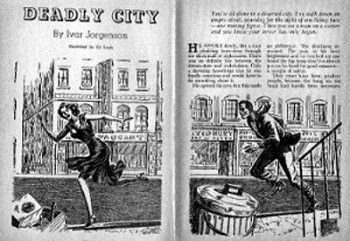
You're
all alone in a deserted city. You walk
down an empty street, yearning for the
sight of one living face -- one moving
figure. Then you see a man on a corner
and you know your terror has just begun...
And
as Nora flees for her life, the
man calls
after her, promising not to harm her,
until he finally corners Nora in an alley.
When she becomes hysterical, he manhandles
her (-- rather roughly),
and
finally has to slap the girl to snap her out
of it. Asked why she ran away, Nora
replies because he's a murderer. Talking
slowly and calmly to her, he rationalizes that he couldn't be
the killer until she settles down. (If not,
I guess you could just slap her silly
again -- ya big bully.) Introducing
himself as Frank Brooks (Richard
Denning), he then relates his own tale of
woe:
Seems
that while waiting out a train layover,
our traveling salesmen mistakenly flashed a large
bank-roll in a
bar to the wrong people. A couple of thugs
then rolled him after several drinks,
knocked him out, and dumped him in alley,
and he didn't wake up until sometime after
noon. Nora offers she woke up late, too,
but doesn't mention the pills.
And now they're together. Alone. Meaning somehow,
in the last ten hours, while they were
both out of it, the entire city has been
evacuated without them. But the bigger
question is: Why was the town evacuated in
the first place? Frank feels it must be
some kind of natural catastrophe, while
Nora fears an H-Bomb attack -- or worse,
some kind of germ warfare. But Frank
doesn't think that's likely; an enemy
wouldn't give enough advance notice to
evacuate a half million people.
Regardless, with all the stray bodies he's
come across, he feels they face certain
death unless they can get out of town.
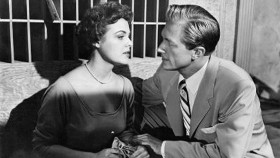
So,
quite inexplicably, they head downtown. (Hey,
Magellan! You're going the wrong way...) When
they come across an electronics store,
Frank breaks in, hoping to find a portable
radio for a news broadcast.
Nora tries the phone but they aren't
working either. Finding only one portable
radio is one too many because there are no
batteries to be found. But before they can get
too frustrated by this development, the
sound of music slowly filters into the
store.
No.
Not Julie Andrews and the Von Traps.
Although I wouldn't mind seeing them all
get melted by death-ray. Heh, that'd be
kinda cool...
Tracing
the tune to a nearby nightclub, inside
they find a woman playing the piano, who,
after finishing the song, and her drink, calls to the bartender for a refill.
Answering the call, another man pops up
from behind the bar with more champagne.
Despite the drunken couple's heated
bickering, Frank and Nora risk talking to
them in hopes of finding out what's going on.
They're friendly enough, but our couple
still have no luck; the lushes have been
on a bender since the night before and
remember nothing. (Thems
my kind of people.) Jim Wilson (Richard
Reeves) introduces himself and his
girl, Vicki Harris (Virginia Grey),
and being three-sheets to the wind,
they're both blissfully unaware that
anything's wrong. When Frank fills them in
and suggests that they all head outside
the city to safety, the sozzled couple
shrug him off, more than content to just
drink their way through the apocalypse. (It
worked for me during the whole Y2K fiasco,
even though nothing happened -- except one
helluva hangover.)
Not wanting to leave them behind, Nora
conspires and suggest that they all hit
the famous Club Royal together. Jim
scoffs, saying that joint's five miles out of
town. Catching on to Nora's plan, Frank
offers there are plenty of places for 'pit
stops' along the way. With that option,
Jim and Vicki agree to a pub-crawl toward the city
limits.
Outside,
they spot an abandoned car. Well, not
quite abandoned ... because they find the
owner still inside it -- dead, just like
the woman in the alley. The keys are still
in
the ignition but it won't start, and a
quick check under the hood finds the
distributor cap missing. Then suddenly, out of
nowhere, another wretched refugee pops up
and
warns
that all the cars have been sabotaged that
way. Remembering a similar tactic used
during the war, Frank tells the others it's
so enemy combatants can't use any
abandoned vehicles. Blathering on, Otis (Mort
Marshall) says he came from the
south part of town -- and it looks like a
war zone, with more dead bodies and
destroyed buildings. Suddenly, Vicki screams
and points to a strange and menacing
shadow looming on a nearby building -- and whatever
is causing that silhouette is most definitely
not human!
As
they all scramble to get
out of sight, Frank herds them into an
abandoned hotel. Inside, the lobby is
strewn with newspapers screaming of an
INVASION! by unknown forces that landed
just outside the city. Reading further,
they discover that the military ordered
the strategic evacuation that missed them
all. The fidgety Otis doesn't think
they're safe and should move on, but the
others want to stay, regroup, and plan an
escape route. Out-voted, Otis decides to
strike out on his own, and strike out he
does, when the little man doesn't get very
far before a large, metallic (--
and more than a little goofy looking --)
robot clunks its way outside the opposite
building.
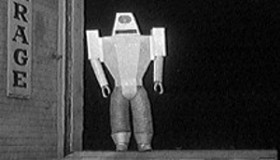
As
the others helplessly watch out the lobby
window, the robot fires a death-ray from
it's large, cyclopean eye that strikes the
fleeing Otis, who quickly falls dead.
Ordering everyone upstairs, Frank brings
up the rear as they quickly get out of
sight. Holing up in a large suite, the
plan is to wait until dark before before
trying to move on again. Feeling trapped, Nora
frets but Frank assures her that the army
must be doing something to handle the
threat -- whatever the hell that metallic
monstrosity really is.
Well,
they are working on it, but without much luck. Like
our stranded group, the
military authorities have a lot of
questions -- Who are they? Where did they
come from? And how do they work? -- but few
answers. The general consensus is that the
rampaging robots are extraterrestrial in origin --
and probably Venusians. (Curse you,
Beaulah!)
And after an entire crack airborne
division was completely slaughtered by the
automatons [-- completely off-screen
*yawn*], General
Wood (Arthur
Space), who's in charge of this
fiasco, changes strategies and calls in an
air-strike. (Cue
stock footage!)
Back
in the hotel, the noise of the jets draws
everyone's attention to the window,
raising fears that they may be sitting on ground
zero. But, before a single bomb can be
dropped on them, the assembled watch as an
alien death-ray
sweeps the sky clean, detonating all the
airplanes in a series of fiery explosions. Twice
witnessing their awesome and unearthly
destructive capabilities, our stalwart
group tries to deduce
where the invaders came from. Since
Frank's old college buddy was an avid
sci-fi geek ['natch], he feels the invaders are from
Venus, too. And while trying to plan their next move, they
slowly realize there is no move to make: they
came from the northern part of town; Otis
came from the west; the aliens landed to
the east; and the Air Force just got
obliterated coming from the south; thus,
they're
completely surrounded by the enemy with no
means of escape. Finding the situation
rather ironic, Nora says yesterday she
wouldn't have cared about dying today.
When Frank asks her to explain, she
confesses that the reason she slept
through the evacuation was a failed
suicide attempt. Frank suspected that, and
asks if she's changed her mind about not
having any reason to live. She says yes,
and they both exchange a smile.
Yep
... she's fallen for the big lug-nut -- and I
don't mean the robot!
Back
at army HQ, General Wood receives word
that the atomic field-artillery pieces
have finally arrived but it will take some
time to get them operational before they
can, hopefully, bloody the invaders nose a
bit. Obviously, the General doesn't like using
atomic weapons on American soil -- but he
has little choice, because nothing else
seems to be working. Knowing his beleaguered
lines can't hold out much longer, and the
enemy is threatening to break out of the
city, Wood is about to sign the order to
fire-when-ready when word comes that
they've finally captured one of the
invaders.

Surprised
to find the prisoner in the science lab,
Wood is then informed that the POW -- and
all the invaders -- are just robots, not
some aliens in body-armor. Completing his
initial examination on the defunct
machine, the head scientist
(Whit
Bissel) sadly concludes that the
only reason they caught this one is
because it probably malfunctioned somehow,
with the only visible damage a cracked
faceplate. Even a cursory look at the
robot's exterior shows that it's far
beyond our own terrestrial technology. Deducing
that it must be remote-controlled by
electromagnetic impulses keyed to a
cathode-ray tube socked somewheres inside the
robot's head piece, the gathered experts
try to
determine how far away the transmitting
aliens could be. Hoping to triangulate the
source signal, and then wipe it out, Wood
asks how big are the robot's antennae. But
the robot has no visible aerial, leading
to more theorizing that the whole chassis
is probably used to pick up the signals --
so who knows where it's coming from,
meaning there is no chance of tracing or
jamming the deadly frequency. Further
study of the robot "corpse"
reveals that the cathode ray tube that
processed the signals somehow broke,
rendering it useless. (Cheap
Venusian crap!) Wood takes that as
good sign; the seemingly invincible
invaders can be stopped. But the
scientist reminds him that the robots are
bullet proof, so another frontal attack
would still be fruitless until they figure
out what cracked the tube. Asked for more
time, General Wood reminds them that time
is quickly running out.
Later, at the hotel, the women are starting
to panic. Seems the men went out to find
some supplies but aren't back yet.
Luckily, they soon arrive, un-atomized, with food and candles. Eating quietly,
Vicki wonders how long they'll have to
stay holed up. When Frank says it's up to
the army, Nora asks which army: Ours or
theirs? On that sour note, they couples
spread out a bit. And as Jim and Vicki start bickering
bitterly again, Nora confesses to Frank it was
the same way with her own husband -- like the time they
were driving home, where it got so heated
that he didn't see the car that hit them.
When Nora woke in the hospital, she was
told her husband was killed. That was six
months ago, and the survivor's guilt
finally caught up with her last night. Assuring
her that it wasn't her fault, Frank
encourages her to get some rest. Indubitably,
since
this is the 1950's, Vicki and Nora will
take the bedroom while Frank and Jim sack out
in the living room. Later, after they
all fall asleep, Nora hears someone trying
to break in and screams.
Alerted, the
men try to hold the door but two
gunshots convinces them to open up --
revealing a very greasy-looking assailant.
Assuming he's a looter, the intruder
claims valuables aren't what he's after and turns
a lecherous eye toward the women. Bullying
his way inside,
he takes them hostage and constantly
reminds them he's in charge because of the
gun.
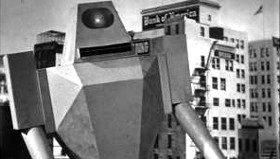
Early
the next morning, Vicki swears she's seen
Davis (Robert
Roark), the armed intruder,
somewhere before and notes his gun looks
like a police revolver. Ignoring her, Davis follows
Nora into the kitchen and tries to get a
little too friendly, offering she can be
safe with him or dead like the others.
Seems Davis plans to use them all as
decoys, bait, to lure the robots away, and
then sneak into the sewers and walk under
the enemy to safety. Nora slaps him and
says he's crazy, but Davis just shrugs the rejection
off and herds everyone down to the lobby...
Back
at army HQ, with the clock rapidly ticking
down, General Wood opens the latest
briefing by insisting this is the
scientists last chance to give him a
non-nuclear solution. With about five
minutes left before the missiles are
fired, the head technician starts cranking
up an oscillator, bombarding the robot's
head with sonic waves. The metal casing
does begin to vibrate, but stubbornly
refuses to break. Desperate, they crank up
the volume...
In
the hotel lobby, Davis threatens to shoot
Jim if Vicki won't check outside for
robots. She concedes, and spots one down the street, heading away from the
hotel. Then, when Vicki finally recognizes
Davis as a convicted killer, the creep
cops to killing a guard and stealing his
gun during the evacuation, and then
reveals his plan of using them all as
bait. But Jim refuses to be his pigeon,
and Vicki concurs, saying there are four
of them, and one is bound to get him --
and the whole thing is moot, anyway,
because she doesn't think he has the guts
to shoot. (I
pause to remind you, m'dear, that he has
killed someone already!)
With that, Davis shoots Vicki ... twice. (I
told ya!) Frank makes a lunge at
him, and takes a bullet in the arm, giving
Jim the opening he needs to get a hold of the
creep and strangle him to
death. Alas, all the noise has
alerted the robot to their presence, and, as it crashes through the window, Jim
empties the revolver with no effect. As the robot opens up with its
death-ray, the dwindling group retreats
back up the steps. Chasing them all the
way up to the roof -- well, give him a
second, Mr. Clunky is having some trouble
negotiating the steps -- Jim tries to hold
it off at the door
while the others try to find another way
down. No go; they're stuck. And after the
robot bursts through the door, it blasts Jim
with its death-ray and then closes in on
Frank and Nora.
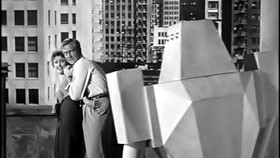
Trapped
for good this time, Frank
embraces Nora and they wait for the end,
together. But salvation comes when the air
is pierced with a strange, high-pitched
shriek. Then, the robot starts to falter
as the noise gets closer. Looking over the
side, the couple spots a convoy of army
jeeps mounted with loudspeakers moving
down on the street. After the robot
finally keels over and expires, Frank
signals the convoy and they stop.
Asked
if they know they're in a live combat
zone, Frank gives them the quick version
of their predicament, and then asks what
that noise was. A Captain explains it's an
oscillator, and the sound vibrations are
disrupting the inner workings of the
robots, knocking them out, and rendering
them useless. Nora
asks if it's over, then. To which the
Captain replies, that yes, they've stopped
them -- this time! And they were lucky: if
the cathode-ray tubes were made out of the
same metal as their armor, instead of
glass, then all the oscillators in the
world would have been useless. (I
wouldn't say that very loud, ya idiot.)
He assures Nora not to worry, though,
because their top scientist are working on
how to counteract that variable even as we
speak. He then tells them to pile in and
they'll get Frank to a medic. And after
the oscillator cranks back up, sending out
the world saving signal, they head for
home.
The
End
One
of the biggest changes that Herman Cohen made to
Fairmont's original story, aside from
dropping Nora's given profession, was
turning the howling and mostly unseen
alien invaders into lethal robots. The story breaks down a little
here: the aliens have the technology
to build these nearly indestructible
machines, and can control them
all the way from Venus, but the technology
is still based on tubes and transistors? Okay...
Upon
first glance, these robots will also probably have
you giggling. Their refrigerator-box frame
and air-duct origins of the arms and legs are hard to
overlook, but if you can
manage to get past all that and notice the
robot's squat nature and odd body proportions, you
realize it doesn't necessarily scream out
... "Look,
there's a guy in a bad robot suit."
Designed and constructed by David Koehler,
the suit was worn by Steve Calvert, who
also played the gorilla in both of Cohen's
earlier films -- in fact, Calvert's entire
career consisted of playing gorillas and
other strange beasties. And at some
point you'll also probably notice that we never see more
than one of these automatons at a time.
Well, there's a good reason for that.
With such a meager budget Koehler was only
able to produce one robot suit, and that's
why we never see the advancing robot army
-- just the "advanced scouts."
Beyond
the robots, the movie stays fairly
faithful to the story. Turning the
directing reins over to long time
film-editor, Sherman Rose, the interior
scenes were shot at the old Charlie
Chaplin studios while the exteriors were
filmed on the streets of Los Angeles over
several weekends without permission or any
permits. Shooting very early in the
morning whilst everyone else was still
asleep, Sherman managed to get what they
needed while the streets were empty. In an
interview in Tom Weaver's Attack
of the Monster Movie Makers
Cohen
relates how one shot was ruined when a
church service ended and the congregation
spilled out onto the street. Despite all
these technical stumbles, I think the film
overachieves well past its limited budget.
With a minimalist and no-nonsense approach
-- both in front of and behind the camera
-- the end result is a creepy, atmospheric
tale filled with a impending paranoia and
claustrophobic dread.
|
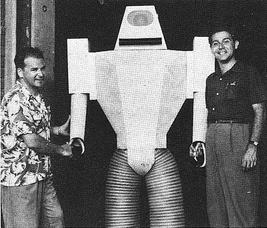
|
|
L
to R: Director Sherman Rose,
Venusian Robot, Producer Herman
Cohen |
Breaking
it down even further, again at first
glance, the feature comes off as another, typical entry in the alien
invasion/Red Scare-paranoia genre of the
1950's. Described as being inhuman and indestructible, with no fear
or sense of feeling, the aliens behind the
robots sure sound like some godless heathen communist
to me! And the Captain's warning at the end resonates
because we we're lucky to stop them this
time. And we must always be prepared, and
vigilant, because those commies -- excuse
me, the aliens will be back; but the
film assures us that we'll be ready for
them, though. But once you get past that
and look a little closer, the film is also
very atypical of the genre.
The heroine tries to
commit suicide; the hero doesn't have all
the answers, and in fact, leads them into
danger instead of out it; and the other
protagonists are both raging alcoholics. The
late entry of the armed killer seems a little
forced, but I guess they had to get them
out of the hotel room somehow -- and it
should be noted that
the weak-link actor playing the creep was the son of
one of the financiers.
And
that's
probably the main reason why I like this
movie; it wasn't afraid to try something
different. It starts strong, with it's
sense of isolation -- so much so, that it
borders on desolation despite the fact
that everything is still standing.
Admittedly, it falls apart in the third
act a little, but it still works for me.
Why? That's easy: I like
sci-fi movies with big clunky robots
in them as opposed to those more
streamlined models that look like us (--
or
replace us? Creepy.) I also like
cosmic death-rays blowing things up; and square-jawed
heroes who can think fast and use their
fists; and I like pretty heroines who do
more than scream and can handle
themselves; and I really, really like it
when the military comes to the
rescue and kicks a modicum of alien butt
before the closing credits roll.
Target
Earth
definitely fits that bill, rather easily.
I'd hesitate to call it a genre classic,
but I like it. A lot.
Of
course, Cohen used the film as a
springboard to further B-Movie infamy
with the teen-angst inspired hits I
Was a Teenage Werewolf,
Teenage
Frankenstein,
and Blood
of Dracula for
his old pal Jim Nicholson and American International Pictures.
In fact, according to Cohen, Nicholson had
asked him to be his partner first when he
formed the new production and distribution
company but had to turn him down because
he was contracted to United Artists at the
time (--
a contract that quickly fizzled after a
couple of box-office duds. For
more on that, check out my review of
Cohen's Konga.) Nicholson
and his eventual partner, Sam Arkoff,
would go on to produce hundreds of films,
including another feature based on a Paul W.
Fairman story, The Cosmic Frame,
that eventually translated into Invasion
of the Saucer Men.
As for Cohen, after a few more pictures
stateside, he moved his
operations to England and Anglo-Amalgamated,
where he produced the likes of The
Black Zoo and Horrors
of the Black Museum.
Then later on in the 1970's, his career
closed out with a
couple of Joan Crawford vehicles, Berserk
and Trog.
And
with Cohen's passing in June of 2002 after a lengthy battle with
throat cancer, we
lost yet another valued member from the B-Movie's
golden age. And what's really depressing is there aren't that many of them
left! Luckily for us, we still have their
films, like Target
Earth, to look at, laugh
at, love, and enjoy.
|